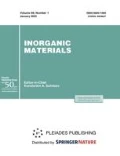Abstract
We have studied the key features of the chemical bonding in hexagonal and rhombohedral antimony and determined polymorphism boundaries that would allow one to extend technological potentialities of creating novel antimony-based materials.
Similar content being viewed by others
References
Lazarev, V.B., Shevchenko, V.Ya., Greenberg, J.H., and Sobolev, V.V., Poluprovodnikovye soedineniya gruppy AIIBV, (II–V Semiconductors), Moscow: Nauka, 1978.
Ashcheulov, A.A., Gutsul, I.V., Manyk, O.N., et al., CdSb, ZnSb, and CdxZn1 − x Sb low-symmetry crystals: Chemical bonding and technological aspects, Inorg. Mater., 2010, vol. 46, no. 6, pp. 574–580.
Psarev, V.I., Thermal rearrangement of atoms in Cd-Sb melts, Russ. J. Phys. Chem. A, 1997, vol. 71, no. 6, pp. 938–942.
Psarev, V.I. and Kostur, T.A., Phase diagram and structure of Cd-Sb Melts, Izv. Akad. Nauk, Neorg. Mater., 1977, vol. 13, no. 12, pp. 2140–2143.
Almin, K.E., The crystal structure of CdSb and ZnSb, Acta Chem. Scand., 1948, vol. 2, pp. 400–407.
Materials Used in Semiconductor Devices, Hogarth, C.A., Ed., Interscience: New York, 1965.
Drits, N.E., Svoistva elementov (Properties of Elements), Moscow: Metallurgiya, 1985.
Ashcheulov, A.A., Manik, O.N., and Marenkin, S.F., Cadmium antimonide: Chemical bonding and technology, Inorg. Mater, 2003, vol. 39,suppl. 2, pp. S59–S67.
Landau, L.D. and Lifshitz, E.M., Teoriya uprugosti (Theory of Elasticity), Moscow: Nauka, 1965.
Leibfried, G., in Handbuch der Physik, Flugge, S., Ed., Berlin: Springer, 1955, vol. 7, part 1, p. 104.
Frantsevich, I.N., Voronov, F.F., and Bakuta, S.A., Uprugie postoyannye i moduli uprugosti metallov i nemetallov. Spravochnik (Elastic Constants and Moduli of Metals and Nonmetals: A Handbook), Kiev: Naukova Dumka, 1982.
Ubbelohde, A.R., The Molten State of Matter, Chichester: Wiley, 1978.
Author information
Authors and Affiliations
Corresponding author
Additional information
Original Russian Text © A.A. Ashcheulov, O.N. Manyk, T.O. Manyk, S.F. Marenkin, V.R. Bilynskiy-Slotylo, 2013, published in Neorganicheskie Materialy, 2013, Vol. 49, No. 8, pp. 823–826.
Rights and permissions
About this article
Cite this article
Ashcheulov, A.A., Manyk, O.N., Manyk, T.O. et al. Some aspects of the chemical bonding in antimony. Inorg Mater 49, 766–769 (2013). https://doi.org/10.1134/S0020168513070017
Received:
Accepted:
Published:
Issue Date:
DOI: https://doi.org/10.1134/S0020168513070017


